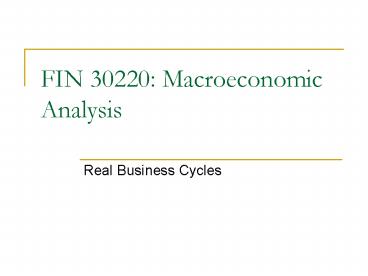Real Business Cycles PowerPoint PPT Presentation
Title: Real Business Cycles
1
FIN 30220 Macroeconomic Analysis
- Real Business Cycles
2
A Complete Business Cycle consists of an
expansion and a contraction
recession
Peak
Trough
Expansion
3
Since WWII, the US has experienced 10
contractions lasting an average of 10 months
(from peak to trough) 63 months from peak to
peak
4
All business cycles are alike in that there are
regular relationships between various
macroeconomic statistics
Correlation .81
Consumption is one of many pro-cyclical variables
(positive correlation)
5
All business cycles are alike in that there are
regular relationships between various
macroeconomic statistics
Correlation -.51
Unemployment is one of few counter-cyclical
variables (negative correlation)
6
All business cycles are alike in that there are
regular relationships between various
macroeconomic statistics
Correlation .003
The deficit is an example of an acyclical
variable (zero correlation)
7
All business cycles are alike in that there are
regular relationships between various
macroeconomic statistics
Productivity is pro-cyclical and leads the cycle
8
All business cycles are alike in that there are
regular relationships between various
macroeconomic statistics
Inflation is pro-cyclical and lags the cycle
9
Business Cycles Stylized Facts
Variable Correlation Leading/Lagging
Consumption Pro-cyclical Coincident
Unemployment Countercyclical Coincident
Real Wages Pro-cyclical Coincident
Interest Rates Pro-cyclical Coincident
Productivity Pro-cyclical Leading
Inflation Pro-cyclical Lagging
The goal of any business cycle model is to
explain as many facts as possible
10
We have a simple economic model consisting of two
markets
Capital markets determine Savings, Investment,
and the real interest rate
Labor markets determine employment and the real
wage
Employment determines output and income
Real business cycle theory suggest that the
business cycle is caused my random fluctuations
in productivity
11
We have developed a model with a labor market and
a capital market. Suppose that a random,
temporary, negative productivity shock hits the
economy. (Assume no government deficit)
Drop in productivity
For a given level of employment and capital,
production drops
12
At the pre-recession real wage, the demand for
labor drops due to the productivity decline
Drop in productivity
The first market to respond is the labor market
13
The drop in labor demand creates excess supply of
labor real wages fall and employment decreases
Drop in employment
The drop in employment creates an additional drop
in production
14
The capital market reacts next
The drop in income relative to wealth causes a
decline in savings
Drop in Income
Wealth is unaffected
Expected Future productivity is unaffected
Non-Labor income is unaffected
Expected Future employment is unaffected
The interest rate will need to adjust to equate
the new level of savings
15
The drop in savings creates excess demand for
loanable funds
Drop in Income
Wealth is unaffected
Expected Future productivity is unaffected
Non-Labor income is unaffected
Expected Future employment is unaffected
The real interest rate rises and levels of
savings and investment fall
16
Recall that todays investment determines
tomorrows capital stock.
Depreciation Rate
Purchases of New Capital
Tomorrows capital stock
Remaining portion of current capital stock
If investment falls enough, the capital stock
shrinks this is what gives the recession legs
17
The drop in the capital stock worsens the
recession
Drop in capital
The drop in the capital stock creates an
additional drop in production
18
Even at the lower wage, a drop in the capital
stock further depresses labor demand
Drop in capital
A second labor market response further lowers
real wages and employment production falls
further
19
A drop in the capital stock creates expectations
of persistent declines in employment which begin
to influence investment demand
Income continues to fall
Drop in expected future employment
A second capital market response further lowers
savings, and investment with both investment
and savings affected, the interest rate effect is
ambiguous
20
How do we know when weve hit rock bottom (i.e.
the trough)?
Falling employment lowers the productivity of
capital (labor and capital are compliments while
a falling capital stock raises the productivity
of capital (diminishing MPK). Eventually, these
two effects offset each other.
21
The Recession of 1981 is officially dated from
July 1981 to November 1982
22
The Recession of 1991 is officially dated from
July 1990 to March 1991
23
The most recent recession is officially dated
from March 2001 to November 2001
24
Are recessions caused by high oil prices?
Recession Dates
25
Are jobless recoveries the new norm?
Employment ( Deviation from trend)
Look at the change in employment following the
last three recessions!
26
What was different about the 2001 Recession?
Productivity ( Deviation from trend)
Productivity was actually growing during the 2001
recession!!
27
As was mentioned earlier, the 2001 recession was
different in that it was almost entirely driven
by capital investment rather than productivity
- Collapse of the stock market
- The Dow dropped 30 from its Jan 14, 2000 high of
11,722 - The Nasdaq dropped 75 from its March 10, 2000
high of 5,132 - The SP 500 dropped 45 from its July 17, 2000
high of 1,517 - Y2K/Capital Overhang
- A sharp rise in oil prices (oil prices doubled in
late 1999) - Enron/Accounting scandals
- Terrorism/SARS
28
Can preference shocks cause recessions?
If recessions are caused by a sudden drop in
labor supply, then wages would be countercyclical
(rising during expansions)
29
Can preference shocks cause recessions?
If households suddenly lower consumption
expenditures (increase savings), the drop in
interest rates should trigger an offsetting rise
in investment spending
30
It seems as if random fluctuations to
productivity are a good explanation for business
cycles. However, there are a couple problems
If productivity is the root cause of business
cycles, we would expect a correlation between
productivity and employment/output to be very
close to 1. The actual correlation is around .65
Where do these productivity fluctuations come
from? Is it possible to separate technology from
capital?
Havent we left something out?

